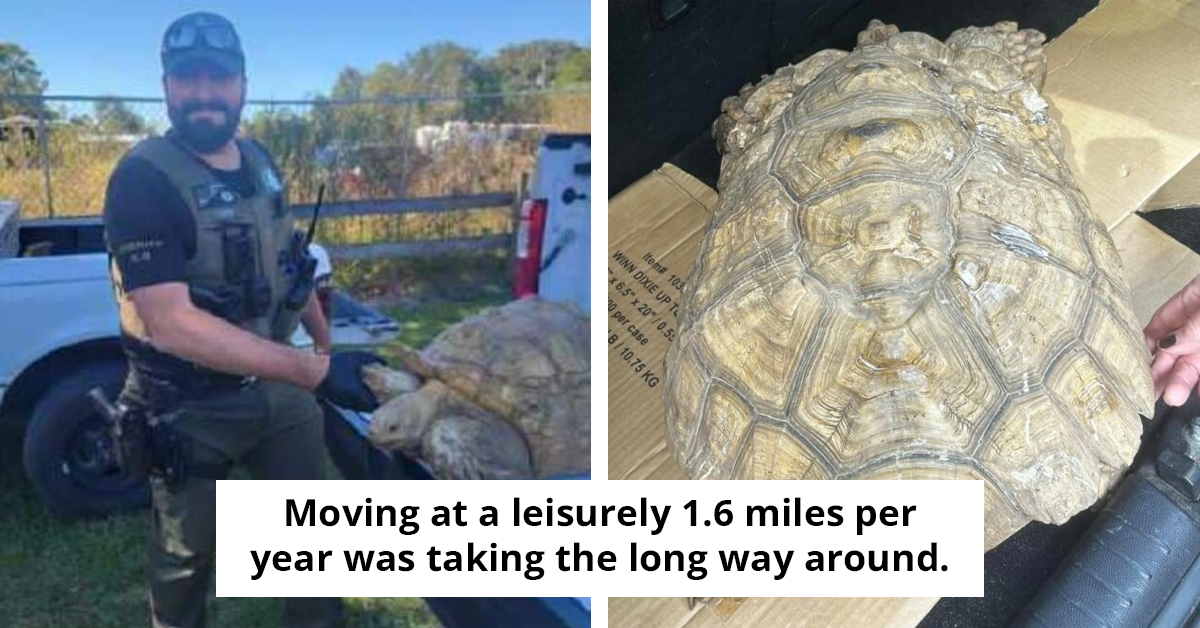Young Woman Asks How To Deal With Boyfriend Who Believes Her Dog Is Dangerous And Wants To Call Animal Control
Sometimes, when kids and dogs are together, even a tiny mistake can turn into a big problem. This story is all about how that can happen and why it's so important to watch over kids and pets carefully.
OP has a one-year-old child with her boyfriend, Hank. He does not like dogs, and coincidentally, OP owns a German Shepherd.
Fortunately, they do not live together, so Hank doesn't have to interact with the dog. Recently, something unfortunate occurred to OP's dog, resulting in a broken leg.
Fast forward to the present day: the dog is lying on the floor in the same room as OP's daughter, who has just started learning to walk and tends to stumble frequently. OP also has her sister over at the moment. Unfortunately, OP was not paying attention and didn't notice her daughter wobbling towards the dog.
Her daughter accidentally fell on the dog's broken leg, causing the dog to yelp and bark, though it didn't show aggression. The dog got up and left the room. Although her daughter was startled, she did not cry. OP fully accepts the blame for not paying attention.
Her sister, who is also not fond of dogs, was spooked. OP asked her not to inform Hank, as she feared he would exaggerate the situation.
However, her sister went against her wishes and told Hank, leading to a heated reaction from him. Hank accused the dog of being dangerous and threatened to call animal control. OP's mother also learned of the situation and suggested getting rid of the dog to resolve the tension.
OP vehemently disagreed, insisting that it was an unfortunate accident. For the time being, OP has decided to keep her daughter away from the dog to prevent a similar incident.
Hank did not drop the issue and proceeded to call animal control, but it did not lead to any significant consequences. Interestingly, the relationship between the dog and OP's daughter remains positive, with the dog returning to the living room and sitting in its usual spot.
OP questions whether her actions were wrong.
OP has a one-year-old child with her boyfriend Hank, but he dislikes dogs; luckily, he doesn't have to interact with her German Shepherd because they don't live together.

OP's dog had an accident and broke her leg.

OP's daughter accidentally bumped into the dog's broken leg, causing the dog to yelp and bark at her, but there was no aggression.

Exploring the Fear of 'Dangerous' Dogs
Dr. Ramani Durvasula, a clinical psychologist, emphasizes that fears about certain dog breeds are often rooted in societal stereotypes rather than actual behavior. She states, "Many dogs labeled as ‘dangerous’ are simply victims of misunderstanding, which can create unnecessary tension in communities." The influence of media in shaping these perceptions can lead to overreactions from individuals who may not fully grasp canine behavior. To address these misconceptions, Dr. Durvasula suggests that "educating the public about dog behavior and body language is crucial for alleviating these fears." For more insights, visit her professional website at Dr. Ramani's website.
OP's daughter got scared but didn't cry, so OP warned her sister not to tell Hank to avoid making it a bigger issue.

She did it anyway, and he got angry and threatened to call animal control, but OP tried to explain that it was just an accidental mistake.

OP is concerned about her daughter's safety around the dog after the recent incident and feels guilty.

From a cognitive-behavioral perspective, these fears can create a cycle of avoidance and misunderstanding. When individuals perceive a dog as dangerous, they may avoid interactions, which can reinforce their fears and lead to increased anxiety. This cycle can escalate tensions between dog owners and their neighbors, making it essential to address these fears through education and dialogue.
The dog's response shows it's safe for kids.
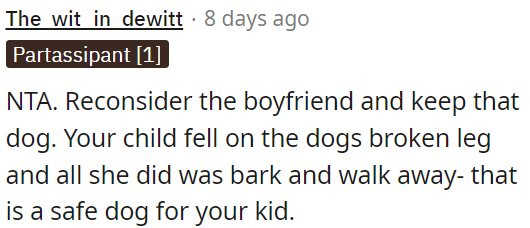
The dog isn't violent despite barking.
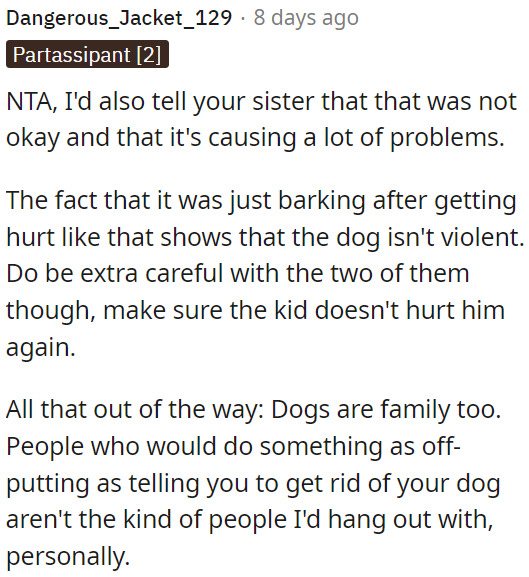
OP's dog reacted to protect herself.
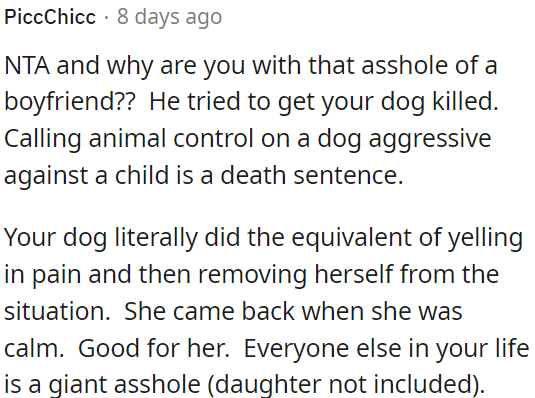
Effective Communication Strategies
For dog owners facing concerns about their pet's behavior, proactive communication is key. Engaging neighbors in conversations about the dog’s training, temperament, and the owner’s commitment to responsible pet ownership can foster a sense of security. Offering to introduce the dog in a controlled environment, such as a short walk together, can also help dispel fears.
Experts suggest using positive language and active listening techniques during these discussions to ensure that neighbors feel heard and understood, which can pave the way for more positive interactions.
OP should reevaluate her relationship with Hank, as he may take matters into his own hands if animal control doesn't help.
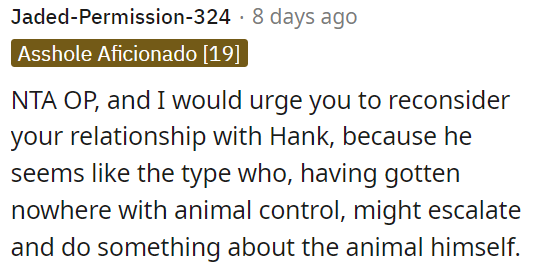
The boyfriend can't be trusted.

OP should be more cautious with a baby around an injured dog due to potential unpredictability.

Understanding the psychological basis of neighborly fears can also involve exploring attachment styles. Individuals with insecure attachment may project their fears onto unfamiliar situations, perceiving threats where none exist. Recognizing these patterns can help dog owners approach neighbors with empathy, understanding that their fears may stem from personal experiences rather than the dog's actual behavior.
Most dog breeds are protective of kids.

People who dislike dogs often claim that you can't predict their behavior until a specific incident occurs.
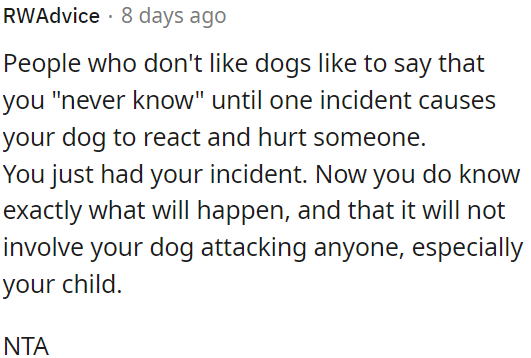
Some people think dogs are unpredictable until something happens, but most dogs are protective of kids. However, when a dog is hurt, like OP's dog with a broken leg, it's essential to be careful around them to keep everyone safe.
The dog's reaction, barking without being violent, shows that it's not a dangerous dog. It was just trying to protect itself. This reminds us that with the right care and supervision, dogs can be great friends for families, even when there are little ones around.
Building Community Trust
Fostering a pet-friendly community involves creating trust and understanding among neighbors. Participating in local events that promote responsible pet ownership can enhance relationships and reduce anxiety around dogs. Educational workshops on dog behavior and training, hosted by local veterinarians or trainers, can also help dispel myths and encourage more positive perceptions of all breeds.
Psychological Analysis
This situation illustrates how misconceptions about dog behavior can lead to unnecessary fear and conflict. It's essential for dog owners to approach these concerns with empathy and proactive communication to foster a more understanding community.
Analysis generated by AI
Analysis & Alternative Approaches
In conclusion, addressing concerns about a dog’s perceived danger requires a combination of education, communication, and community involvement. Research consistently shows that fostering understanding and transparency can alleviate fears and promote harmonious living environments. By engaging with neighbors and creating a culture of awareness, dog owners can help bridge the gap between fear and acceptance.
